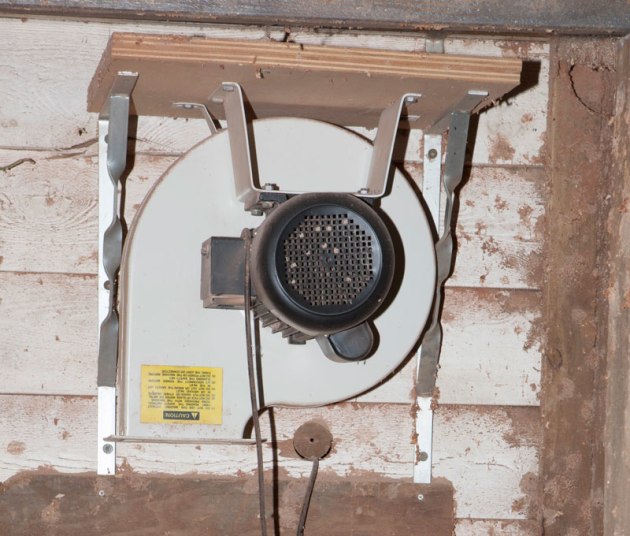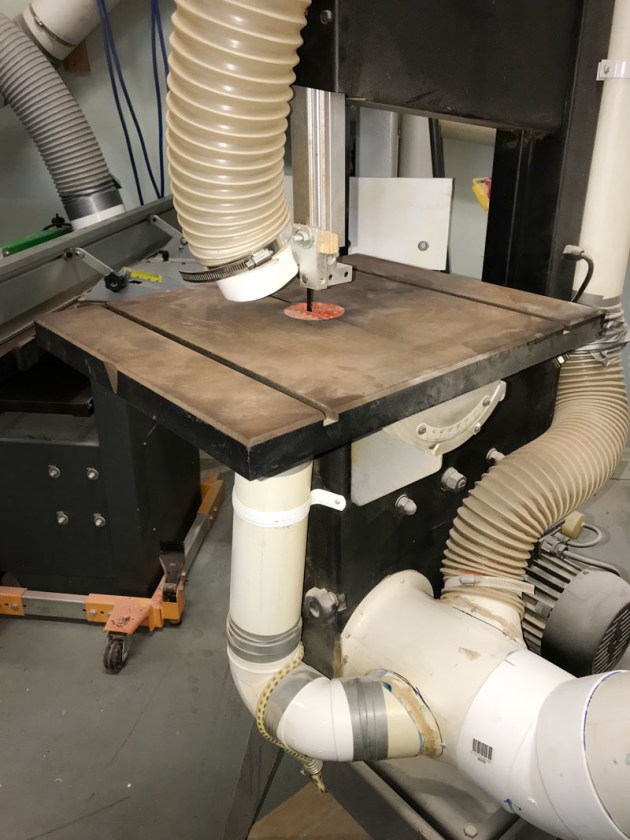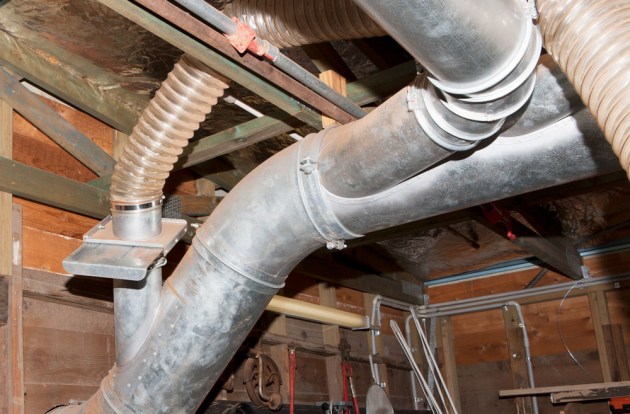Why you should upgrade your dust system
Words: Troy McDonald
I’d like to open this article with two important confessions. First, I’ll confess to having no formal qualifications in dust extraction or ducting design. Whilst I love my woodwork, I have little interest in the formalities of friction losses in ductwork and fan static pressures. So this is an account of my own personal journey in dust extraction shared in the hope that it may provoke thought about your own situation. Thoughts that I hope may have you questioning the adequacy of your own extraction systems as I did when I embarked on this journey a few years ago.
So why is this important? While effective dust extraction techniques are endlessly debated, there is one constant on which the science is aligned. That is the health risk presented by ongoing exposure to fine wood dust. Many of us woodworkers work to self imposed health standards not recognising that the risks of exposure to fine dust increases over time. The recent publicising of silicosis exposure to those working in the stonemasonry and kitchen benchtop industries should serve as a sobering reminder of the need to manage our personal health risks over time. Like many, I remained accepting of the risks until I embarked on a redesign of my workshop several years ago.

Photo 1. An externally installed extractor in its simplest form. A stripped down 2hp impellor with inlet ducted through the workshop wall. The fine dust is free to disperse and the larger wood chips are later raked for compost. Photo: David Bedford
It was then that I removed my trusty 2hp single stage collector from the corner of the room where it had stood for 10 years to find a caked layer of fine dust lining the wall. Only then did I realise my dust collector was a glorified chip collector and dust blower. That afternoon I dedicated a few of hours to relocating the extractor outside the workshop, piping it in through a makeshift arrangement of PVC duct.
I’m embarrassed to admit that it took me another two years to finally improve the system to a degree that I’m now satisfied represents an acceptable (but arguable) level of performance. Along the way I’ve been the fortunate recipient of some sage advice on the topic. Which brings me to my second confession. The ideas for improvement listed below are not my own. Rather, they represent a summary of the guidance from the broader woodworking community that I found useful as I invested both time and money in improving my own system.
1. Extractor location and workshop layout
For those fortunate enough to be designing a workshop from scratch there is an absolute requirement to consider effective dust extraction as a critical element of the design. An early consideration should be where to locate your extractor. As noted above, I was committed to ensuring my extractor remained outside. By nature, this ensures that fine dust collected at the source isn’t recirculated in the workshop environment.

Photo 2. Cyclones can be noisy. Mine required installation in a soundproof enclosure. Shown here with the door open for viewing.
Advice from a number of sources suggested that if you only make one improvement to your system, it should be the relocation of your extractor outside the workshop. If you’re fortunate enough to be located in an open area there are some low cost solutions possible that can be very effective (photo 1) respecting that dense suburban areas can require greater acoustic and dust management to avoid impacting others. In my own situation, locating the extractor outside required an acoustic enclosure to be built (photo 2).

Photo 3. An indoor cyclone system with insulated exhaust duct being vented through the window in the upper right. This ensures there is no exhaust dust being recycled into the workshop.
If you can’t locate the extractor outside then I would strongly recommend you vent the extractor external to the workshop (photo 3).
Recognising you will never capture all fine dust irrespective of your extraction should have you also considering ventilation as part of your design. In warm climates, designing a workshop that ventilates freely is much simpler. In hot or cold environments that require air conditioning the challenges to efficiently ventilating your workshop increase. Opening up your workshop to natural ventilation is a great option, but may not be possible for a number of reasons including climate, security and noise.

Photo 4. Basic Air Filtration System to capture fine airborne dust.
Forced ventilation is the more commonly used solution to remove airborne dust and can be relatively economic to install. The final and most expensive solution to removing remnant air borne dust is air filtration. For cold climates this may be your preferred option. I chose air filtration (photo 4) for my workshop as the suburban location meant managing external noise was a material consideration.
2. Choice of extractor and ducting design
When it comes to choosing an extractor and ducting it’s generally a case of bigger is better. A 2hp extractor should be considered an absolute minimum connected to an individual machine. If you’re intending to run duct to multiple machines then the advice suggests you’ll need a system of 3 or 4hp and above.
There is a wealth of research to support these requirements. Because we’re aspiring to collect fine dust with these systems (not wood chips), the volume of air we need to move through an extraction system becomes significant. Whilst 350cfm may be adequate for wood chips, 1000cfm or more will be required to collect fine wood dust (source billpentz.com).

Photo 5. Most blade guards allow for no more than 50mm ports. The upgrade here to 100mm is remarkably effective.
There are two reasons for this. First of all, we need to understand that fine wood dust behaves like an aerosol. Unlike wood chips it becomes airborne immediately. Secondly, to collect these airborne particles at the source requires significant volumes of air to be drawn into your ductwork. Think of it as trying to create a bubble of low pressure air around the tool generating the dust. The science confirms this as something that’s difficult to achieve. If you’ve used a garden blower you’ll understand the challenge. When used as a blower, they’re effective at blowing dust all over the place, however, switch them to suction mode and you’ll find that you need the inlet right on top of the material you’re trying to vacuum. Why is this? Because blowing has the benefit of efficiently forcing air flow in one direction.
This advantage is lost in a vacuum system as air is drawn in from all directions at once. Once again, collecting fine dust at the source requires large volumes of air to be drawn into your ducting, which requires significant motor power, large impellors and large ductwork.

Photo 6. Modification of a big boy sander. The port is 150mm and the additional removable guarding allows for full dust collection when using the radius.
Choosing a style of extractor is largely a decision between a cyclone (photo 3) or the more conventional single stage extractors with bags or pleated filters. Remember that both of these systems traditionally move exhaust air through some form of filter. As such, the performance of the system is entirely dependent on keeping the filters clean. If you’re like me, this rarely happens at the required frequency.
For decades the majority of large workshops have used cyclone extraction systems for good reason. The inherent cyclone design ensures that separation of the majority of wood dust occurs prior to the impellor so that the exhaust air contains only the finest dust particles.
A single stage system in comparison has all the extracted dust passing through the impellor with subsequent impact on performance. Cyclone systems lose out on cost and noise, however, I chose a cyclone for my installation due to their performance advantage and smaller physical footprint.
The choice of ducting opens up a host of options in either rigid or flexible and metal or PVC. My choice was PVC, purely for the convenience and flexibility, however, there are some very professional metal ducting solutions available. Materials aside, the first consideration should be minimising lengths of ducting and maximising duct size.

Photo 7. With the guarding removed, sanding the full length is possible. Note the upgraded port to the right.
Flexible duct should obviously be avoided wherever possible given the significant resistance to airflow. Recognising the research of Bill Pentz, most owners of standard 2hp extractors nominally rated for greater than 1000cfm of flow may be horrified to recognise that this will be reduced to something closer to 350cfm purely through the choice of 100mm ducting.
Remember, 350cfm won’t provide adequate flow for the collection of fine wood dust. For this reason alone, an early decision I made was to avoid 100mm duct and choose 150mm as standard. The difference is significant with the area of 150mm duct approaching three times that of 100mm. Of course 150mm ducting will not connect to the majority of standard hobbyist equipment which brings us to point three.

Photo 8. An extensive upgrade to a 14" bandsaw illustrates what can be achieved: 150mm main port and 100mm sub ports to both above and below the table.
3. Modifying machinery to achieve greater airflow
Unfortunately, machinery manufacturers have for many years condemned woodworkers to ineffective dust extraction through the design and placement of dust ports. As such, choosing machines that provide for direct connection of 150mm ducting or more commonly modifying existing machinery will be necessary to achieve improved fine dust collection. Modifying professionally made machinery is a concept I personally struggle with. Nevertheless, with the types of inadequacy shown in some machinery the need becomes quite clear and there are considerations that extend beyond the physical upgrade of the port.
Just as important is ensuring there is adequate ventilation within the machine to support the airflow requirements of the larger port. Most of this can be learnt through trial and error, however, be prepared to dedicate time to this work if you are to improve the collection of fine dust at the source. Photos 5–9 provide some examples of the type of modification required to deliver improved outcomes.

Photo 9. Providing adequate ventilation to feed a larger port is critical. Here the front door on the bandsaw is slightly wedged open to ensure adequate air flow to the upgraded 150mm port.
Clearly an article of this scope can only hope to introduce a number of the concepts specific to an effective dust extraction system. As a minimum, reflect on what was discussed in Point 1, i.e. ensure your current extractor vents outside the workshop and consider some form of forced ventilation to assist in the removal of fine airborne dust. Should these not be possible then of course ensure that you wear a properly fitted quality dual cartridge filtered respirator.
These three things alone should significantly contribute to lowering your long term health risks. Beyond that, the unique nature of your own workshop and preferred methods of work will require a range of considerations and possible solutions outlined in points 2 and 3. The desire here is to create curiosity in whether your current extraction system is consistent with managing the health risks associated with your chosen methods of work.
In my case that curiosity was initiated on the discovery of the fine dust lining the walls adjacent to my previous extractor. Having made that discovery and subsequent investment in a number of the leanings shared here, I’m now appreciating a renewed enjoyment of woodworking through the long term health benefits that come from a more effective dust extraction system.
Photos 1–4: Troy McDonald, photos 5–9: John McConnell
Troy McDonald is an engineer and woodworker based in Brisbane. He is a regular contributor to Australian Wood Review magazine. In issue 104 Troy reviews the Veritas shooting board and fence.



